-
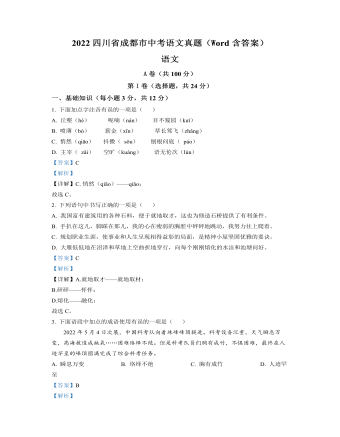
2022年四川省成都市中考语文真题(解析版)
中华民族的传统节日很多,除了端午节,还有元宵节、花朝节、上巳节、清明节、重阳节——这些传统节日的习俗也很丰富。元宵节吃汤圆,猜灯谜,赏花灯。清明节祭先祖,放风筝,荡秋千。二月十二花朝节,民间有“贯红”之俗,文人雅士会相聚饮酒,赋诗唱和。三月三上巳节,人们以香草沐浴,与亲友携游……丰富的习俗让传统节日成为古往今来人们共同的期盼。
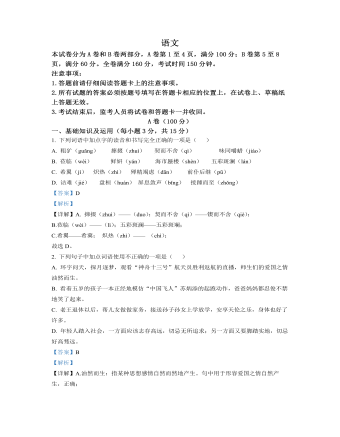
2022年四川省内江市中考语文真题(解析版)
见渔人,乃大惊,问所从来。具答之。便要还家,设酒杀鸡作食。村中闻有此人,咸来问讯。自云先世避秦时乱,率妻子邑人来此绝境,不复出焉,遂与外人间隔。问今是何世,乃不知有汉,无论魏晋。此人一一为具言所闻,皆叹惋。余人各复延至其家,皆出酒食。停数日,辞去。此中人语云:“不足为外人道也。”
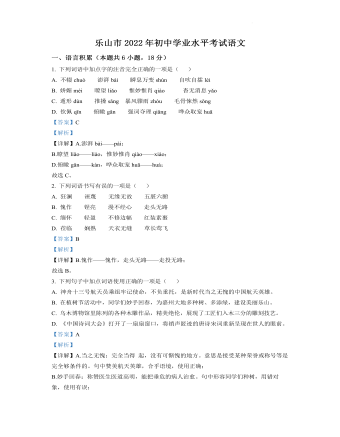
2022年四川省乐山市中考语文真题(解析版)
阅读下面这首宋诗,完成下面小题。插秧歌杨万里田夫抛秧田妇接,小儿拔秧大儿插。笠是兜鍪①蓑是甲,雨从头上湿到胛②。唤渠③朝餐歇半霎,低头折腰只不答:“秧根未牢莳未匝④,照管鹅儿与雏鸭。”【注】①兜鉴:古代战士戴的头盔。②胛:肩胛。③渠:他。④莳未匝:插秧没有完成。
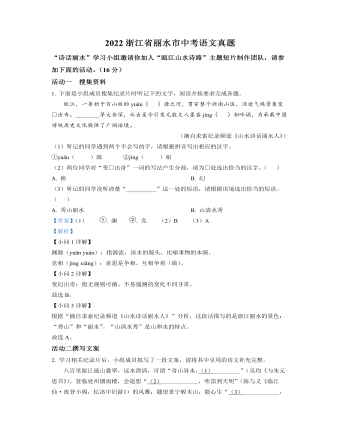
2022年浙江省丽水市中考语文真题(解析版)
莫言,原名管谟业,1955年生于山东高密,著名作家,2012年获得诺贝尔文学奖。据高密管氏族谱记载,高密管氏是从龙泉迁过去的。2010年,莫言到龙泉寻根问祖时表示,自己是高密管氏的第二十四代子孙、龙泉管氏的第三十六代子孙,祖上是北宋名臣、龙泉人管师仁。莫言曾题诗表达对龙泉之行的感想:“龙泉祖居地,山水呈瑞祥。诗成白云岩,根系石马岗。宝剑生紫气、青瓷吐幽光。惭愧我来晚,千里献心香。”
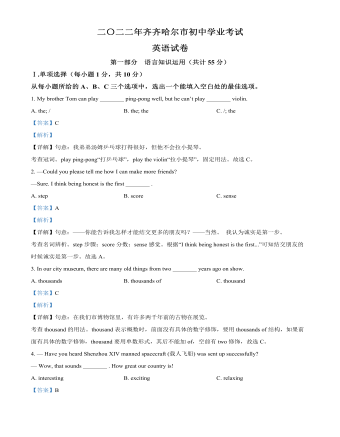
2022年黑龙江省齐齐哈尔市中考英语真题(解析版)
B: For 3 days. I expect togo there again.A: Lucky you. I had to stayat home. But I’m planning to travel to Mount Changbai.B: Oh, that’s a good place.I went there three years ago.
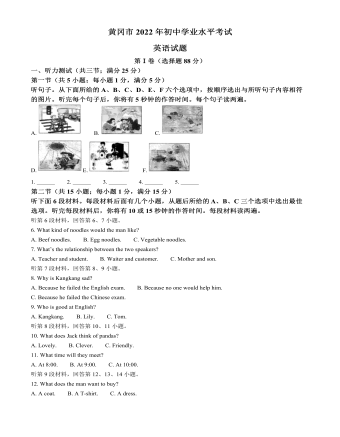
2022年湖北省黄冈市、孝感市、咸宁市中考英语真题(解析版)
When he was 12, his parents died. He was aloneand didn’t ____11____others. No one showed kindness to him. People always laughed ____12____ him. His only friend was adog named Bobby. He ____13____his dog enough to eat and drink, but he was a little rude(粗鲁的)to it sometimes.
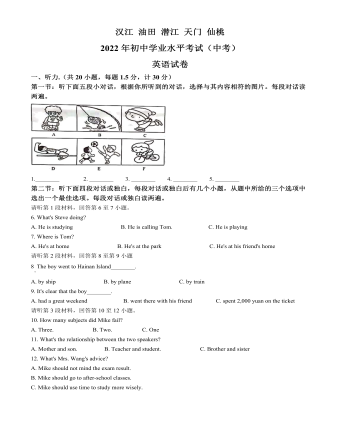
2022年湖北省江汉油田、潜江、天门、仙桃中考英语真题(解析版)
Penny’s family was very poor. Her father was asailor (水手).He earned very little money and was ____16____ away from home. Her mothercould not work ____17____she was often sick. One day.
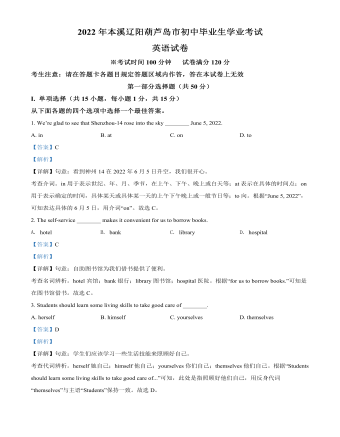
2022年辽宁省本溪市、辽阳市、葫芦岛市中考英语真题(解析版)
A bird went to look for happiness. On ___21___ way, she saw a flower, the flower was short ofwater, but his face was full of ___22___ .
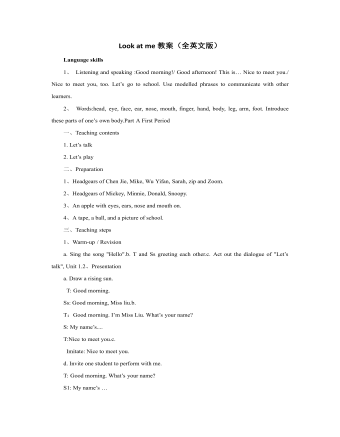
人教版新课标PEP小学英语三年级上册Look at me教案(全英文版)
3、Practicea. Nice to meet you. Nice to meet you,too.b. Perform the dialogue.c. Arrange the dialogue according to the pictures or sentence cards.d. Let’s play.A: Good afternoon,B. This is C. Hello, C! Nice to meet you.C: Nice to meet you, too.A,B: Goodbye!C: Bye!4、Assessment Workbook page 10Add-activitiesa. Listen to the recording and repeat.b. Make a dialogue according to "Let’s talk".Second Period一、Teaching contents1. Let’s learn Words:body, leg, arm, hand, finger, foot.1. Let’s do二、Preparation1、a puppet2、Cards of body, leg, arm, hand, finger and foot.3、headgear of a captain三、Teaching steps1、Warm-up/ Revisiona. Captain says to review "let’s do" of Part A.b. Perform the students their own dialogues.2、Presentationa. Learn to say "body, leg, arm, hand, finger and foot."b. Listen to the recording and repeat.c. Let’s do. Clap your hands. Snap your fingers. Wave your arms. Cross your legs. Shake your body. Stamp your foot.3、Practicea. Let’s draw a person.b. Let’s do. Point out which picture.c. Let’s do. Who responses faster.4、Assessment Workbook page 115、Add-activitiesa. Listen to the recording, repeat and act out.b. Say all the names of the body to your parents.Third Period一、Teaching contents1. Let’s check2. Let’s chant二、Preparation1、stationeries1、pictures of parts of Zoom
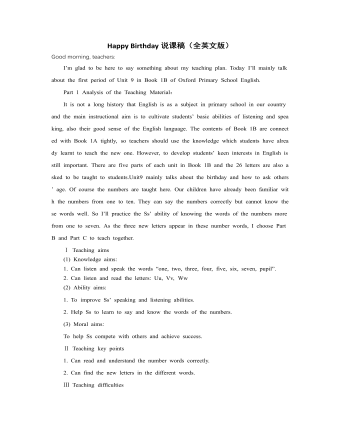
人教版新课标PEP小学英语三年级上册Happy Birthday(全英文版)说课稿
1. Do some exercise on the paper. There are four kinds of exercise here. The exercise 1 is to develop Ss’ ability of listening. Exercise 2 is to practice Ss’ ability of knowing the words. Exercise 3 is to develop Ss’ ability of speaking numbers and letters. Exercise 4 is to make Ss know the words and letters well. These exercises can consolidate the new knowledge from different styles of problems.2. Then tell Ss that we can sing the numbers like “ Do, re, mi, fa, so, la, ti, do” and let them listen to a song named “Do, Re, Mi”. Add some extra knowledge so that Ss will be glad to see that the numbers can be used in another way.Step 4 Homework1.Read the numbers from 1 to 7 and 7 to 1 five times.2.Read the letters “u, v, w” five times follow the tape.Reading is a useful way for the Ss of Grade One to practice the knowledge. Ask Ss to imitate reading from the tape in order to make Ss have a good habit of listening and let them have a better pronunciation.Step 5 Board writingI ‘ll put the seven numbers like a scale(音阶)as I’ll let Ss know that we can sing out the numbers. When it comes to listen to the song, I ‘ll draw a musical note on Bb. Unit 9 Happy birthday!sevensixfivefourthree U u V v W wtwo pupil five windowoneThat’s all for my class designing. Thank you for listening!
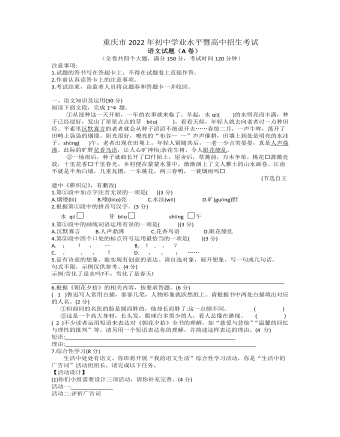
2022年重庆市中考语文A卷
这一天,阳光明亮,大鸟忽然觉得它的双脚可以抬起了。它十分激动地对冰山说:“我能飞了,我能飞了,我可以回家啦!”它扇动翅膀,飞了起来。可是,大鸟很快掉进了海水里。它好几天没吃东西,已经没有一丝力气。
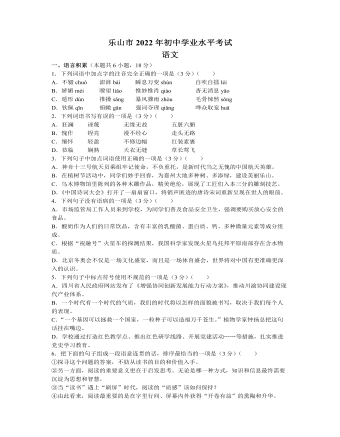
2022年四川省乐山市中考语文真题
中华民族拥有5000多年灿烂文明。弘扬中华美育精神,用美育涵养“美丽心灵”,不妨从教育引导年轻人热爱艺术开始。年轻人通过认识和理解中华大地上的优秀艺术作品,可以形成开阔的视野和包容的心态,增强文化自觉和文化自信。引导年轻人接近、欣赏中国文艺作品之美,有助于赓续优秀文化传统,增强做中国人的志气、骨气、底气。
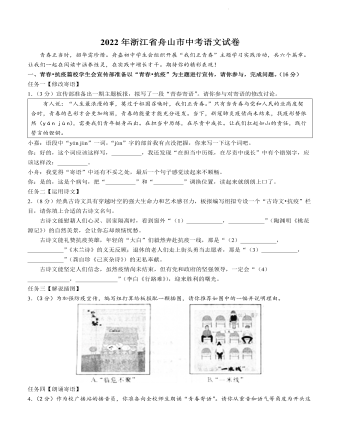
2022年浙江省舟山市中考语文试卷
生平所见之友,以穷以老而遂于衰颓者,十居七八。赤豹②,君子也,久居江东,得无有陨获③之叹乎?昔在泽州,得拙诗,深有所感,复书曰:“老则息矣,能无倦哉?”此言非也。夫子“归与归与”④,未尝一日忘天下也。故君子之学,死而后已。

2022年内蒙古赤峰市中考语文真题(解析版)
题稚川山水【唐】戴叔伦松下茅亭五月凉,汀沙云树晚苍苍。行人无限秋风思,隔水青山似故乡。注:戴叔伦,唐代诗人,此诗作于作者宦游途中。
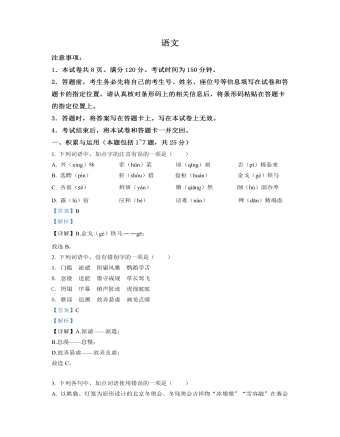
2022年内蒙古包头市中考语文真题(解析版)
夜来似闻某人素心,明日试往看之,入其门,窥其闺,见所谓某人方据案面南看一文书。顾客入来,默然一揖,便拉袖命坐,曰:“君既来,可亦试看此书。”相与欢笑。日影尽去,既已自饥,徐问客曰:“君亦饥耶?”不亦快哉!

2022年湖北省宜昌市中考英语试题(解析版)
Duringwork hours in Becker’s bread shop, the kitchen is especially quiet except thesound of the machine. The quiet environment is not the result of the strictrules, but because all the workers are deaf. They use sign language tocommunicate with each other from time to time.
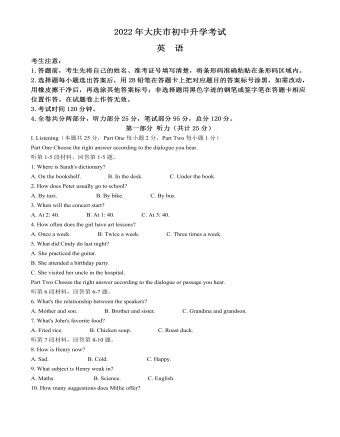
2022年黑龙江省大庆市中考英语试题(解析版)
On a snowy day, there was a man walking in ahurry on the road. His clothes were in poor condition. You might think he was abeggar(乞丐),but in fact he was a painter. His name was Vincent Willem van Gogh.
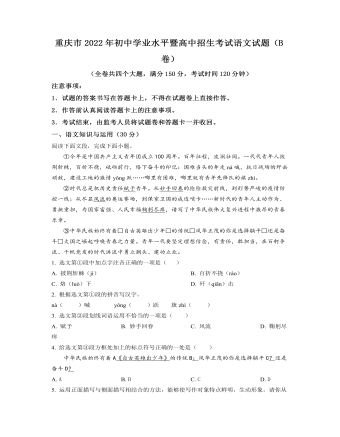
2022年重庆市中考语文试卷(B)及答案
在厨房蒸馒头的母亲,揭开锅盖高兴地说到:“馒头笑了。”我没看出来,就问她怎么笑的。母亲说:“就是馒头开口了,过年了,讨个吉利,所以要说笑了才行。”
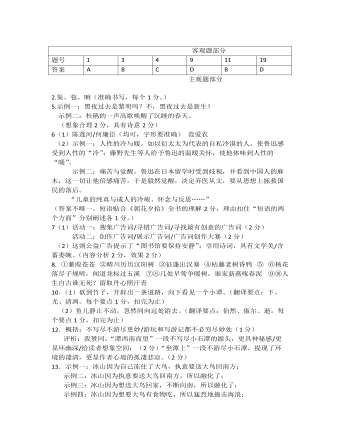
2022重庆中考语文A卷答案
作者通过举例,更具体地说明了“自下而上找结构”的方法;/作者分步骤,更为清晰地讲解了如何从庞杂信息中找到结构;/作者通过高度概括(提炼观点),使读者更为快速地了解从庞杂信息中找到结构的方法。
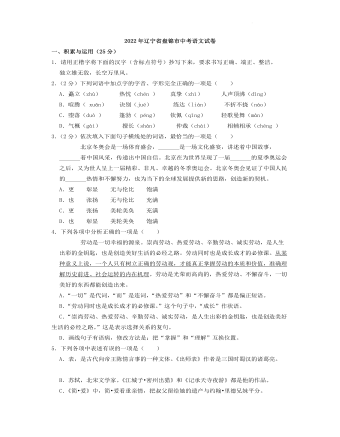
2022年辽宁省盘锦市中考语文真题及答案
①我妈是一个知青,我爸是一个农民。在我幼时的岁月里,我爸应该很辛苦。只有他一个农村户口,却有三个城里人要养活,他的田地太少了。但他勤快,愿意为生活付出所有气力。据说我家永远是每亩地里出钱最多的人家,而他的女儿们却几乎没去过那片土地。